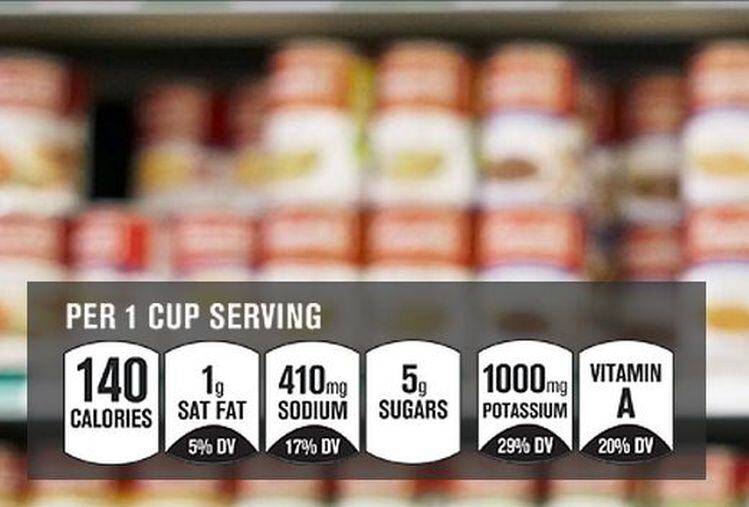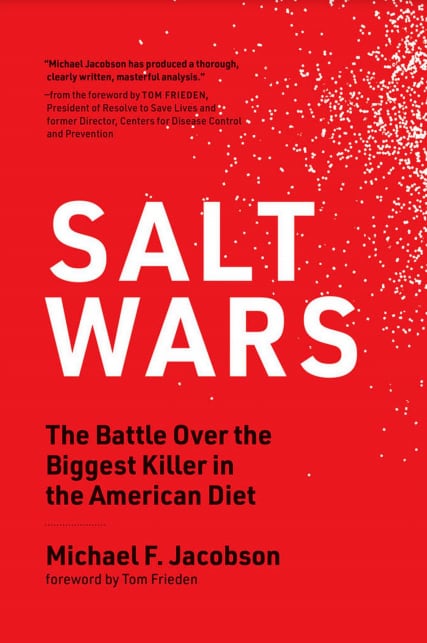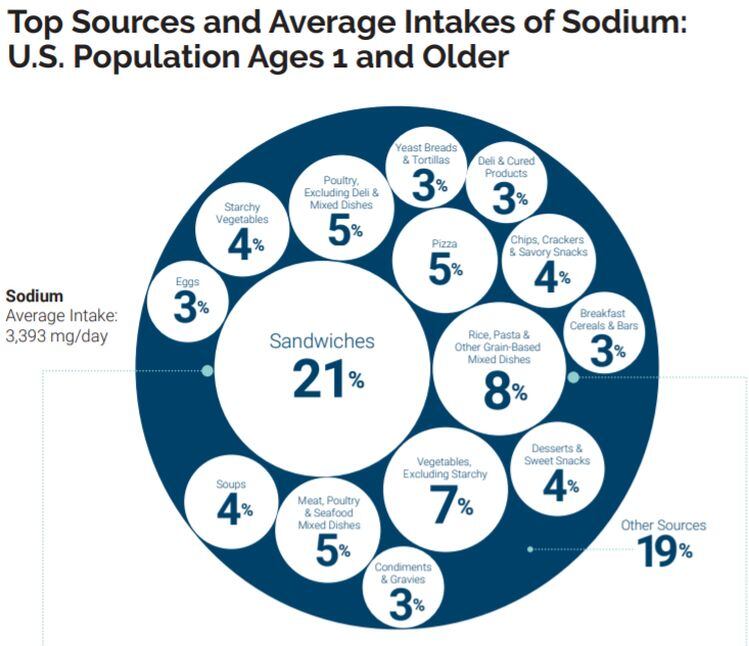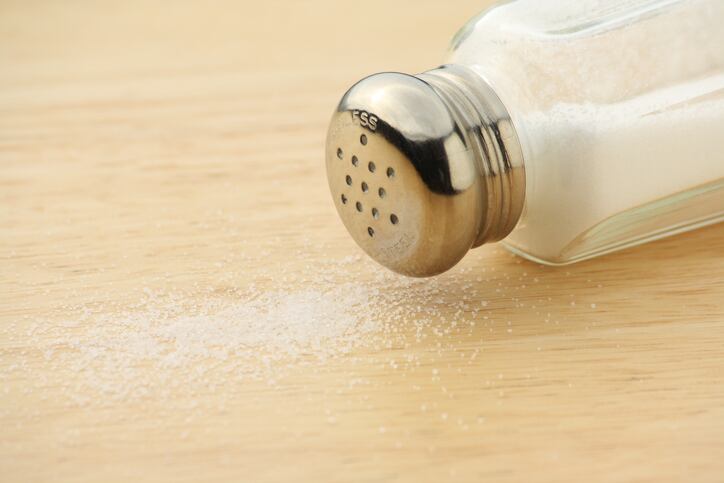The FDA has not committed to a timeline, but told FoodNavigator-USA it “has been working diligently on final guidance for industry with voluntary short-term targets for sodium in various food categories.”
Given that “about 70% of the sodium we consume comes from processed and restaurant food, successful sodium reduction depends on reducing sodium across the food supply,” added a spokesperson.
‘I think we can look forward to progress from the Biden administration’
So is Michael Jacobson, PhD, co-founder of the Washington-DC-based health advocacy nonprofit The Center for Science in the Public Interest (he stepped down as executive director in 2017, but remains a senior scientist) expecting to see some movement this year?
“[Former FDA commissioner Dr Scott] Gottlieb left the agency in spring 2019 just after saying that reducing sodium is a top priority [Gottlieb told Politico in April 2019 that finalized guidance was imminent], so it was disappointing they didn’t finalize the targets,” said Jacobson, who has been on a crusade to reduce sodium in the food supply since the 1970s, when he filed his first citizen petition urging the FDA to revoke the GRAS status of salt (spoiler alert, it didn’t).
“I think we can look forward to progress from the Biden administration,” said Jacobson, who has just written a book documenting his 40+-year battle to reduce sodium in the American diet: Salt Wars: The Battle Over the Biggest Killer in the American Diet.
“I’m hoping that once we have a new FDA commissioner and HHS secretary installed, we’ll see something later this year.
“But what FDA needs to do is finalize goals, and after the two-year mark, see how much progress has been made, and if there is inadequate progress, that provides the foundation for mandatory limits.”
According to the American Heart Association, excess levels of sodium/salt may put people at higher risk for: Enlarged heart muscle, headaches, kidney disease, osteoporosis, stroke, heart failure, high blood pressure (hypertension), kidney stones, stomach cancer
What does 2,300mg sodium look like?
- 1/4 teaspoon salt = 575 mg sodium
- 1/2 teaspoon salt = 1,150 mg sodium
- 3/4 teaspoon salt = 1,725 mg sodium
- 1 teaspoon salt = 2,300 mg sodium
"If we steadily reduced the amount of salt we eat, our perception of what is salty will change steadily as well. If we do this, the food we eat now would taste unbearably salty, and our blood pressure and risk of heart attack would plummet. The war on salt can be won— but only with a concerted and strategic effort that relies on leadership in government and in society." Dr Tom Frieden, former director of the CDC, in a foreword to Dr Jacobson's new book, Salt Wars
“We keep making recommendations and making recommendations and the needle doesn’t move at all.” Eric Decker, head of the Department of Food Science at the University of Massachusetts, Amherst, speaking about sodium at a public meeting of the Dietary Guidelines Advisory Committee, March 2019.
Boys aged 5-8, who should be getting a maximum of 1,500mg sodium per day, are consuming on average, 2,785mg a day
But why do we need targets, and aren’t most leading corporations in CPG and foodservice already committed to cutting sodium?
Yes, said Jacobson, but clearly more work needs to be done, as despite these efforts, Americans are still consuming – on average - around 3,400mg of sodium a day, although the Dietary Guidelines (based on a 2019 report from the National Academy of Sciences) say adults should be consuming no more than 2,300mg.
Indeed, actual intakes could be closer to 4,000mg, says Jacobson (who notes that urinary analysis data also supports this higher figure), given that dietary recall surveys tend to underestimate food intakes and don't account for salt added to food.

Children, meanwhile, are also consuming far too much sodium, he said, with the Dietary Guidelines noting that 97% of 5-8 year-olds exceed recommended limits.
Boys aged 5-8 – who should be getting a maximum of 1,500mg sodium per day, are consuming on average, 2,785mg a day; while girls aged 2-4 – who should be eating no more than 1,200mg, are getting on average, 2,061mg.
9-13 year old boys, who should not exceed 1,800mg, meanwhile, are consuming – on average – a whopping 3,451mg according to NHANES dietary intake survey data.
“Yes, there has been a decline in sodium in packaged foods in recent years," acknowledged Jacobson.
"But consumer intakes haven’t really changed for 30 years because we’re consuming more restaurant foods** – some of these meals have 4,000-5,000mg of sodium, which should come with a health warning - and we're also consuming more calories [USDA ERS data shows average daily calorie intakes rose from 2,016 in 1970 to 2,390 in 2014].”
Most people have no idea how much sodium they are eating each day
But hasn’t labeling made a difference?
Not really, argues Jacobson, who says most people have no idea how much sodium they are eating. A 2017 survey of people leaving fast- food restaurants underscored consumers’ ignorance of sodium levels, he noted in Salt Wars. "Their average meal contained 1,292 mg of sodium. But they estimated— or, more accurately, guessed— that the meals contained only 279 mg."
While new rules requiring chain restaurants with 20+ outlets to display calories on menus or menu boards also require them to provide nutrition information about sodium and other nutrients upon request, he said, how many people do you know routinely request it?

In packaged foods, sodium levels and %DVs have featured on food labels since 1994, while some brands also list sodium on the front of pack as part of the industry-backed, voluntary ‘Facts up Front’ initiative.
Unlike initiatives in countries such as Chile and Israel, where high-sodium foods come with a warning, however, the Facts Up Front icons just pull out data from the Nutrition Facts panel without interpreting it, which has the effect of turning it into so much wallpaper, he said.
Sodium reduction has fallen off the radar
The problem, contends Jacobson, is that while the 2019 National Academies report outlines “both a causal relationship and an intake–response relationship between sodium and several interrelated chronic disease indicators: cardiovascular disease, hypertension, systolic blood pressure, and diastolic blood pressure,” sodium reduction has fallen off the radar at many food companies, who are under more pressure from consumers right now to ‘clean up’ labels and cut sugar (currently public enemy #1 in the nutrition stakes) than to reduce sodium.
But the National Academies report - which also throws cold water on some well-publicized (but Jacobson claims deeply flawed) studies suggesting lower sodium levels could actually cause health problems - makes it clear that lowering sodium should be a top priority for the food industry, he said.
Leveling the playing field
And setting targets to which everyone must adhere is the best way to galvanize industry and make that happen, said Jacobson, both to ensure that our palates gradually adjust to less salty foods, and to level the playing field so companies that make the effort to reduce sodium are not competitively disadvantaged.
While many companies have made progress, he said, the costs required for sodium reduction are not typically offset with any incremental sales (indeed, sodium reduction is often done by stealth and is not something firms typically shout about on food labels), so there has to be an incentive for manufacturers to make the kind of across-the-board reductions needed to deliver a meaningful reduction in intakes.
But the costs of not acting are clear, he claimed: “Excess sodium is for about 50,000 to 100,000 premature deaths and $10 to $24bn in avoidable health care costs in the United States every year. Globally, excess sodium causes about one million premature deaths annually.”
Salt Czar

Indeed, former FDA commissioner Dr Scott Gottlieb told delegates at the Consumer Federation of America conference in Washington in March 2019 that, “There remains no single more effective public health action related to nutrition than the reduction of sodium in the diet,” noted Jacobson.
"Finalizing guidelines will bring sodium back to center stage. But the FDA also should set intermediate goals between 2- and 10-year goals, because it will help people maintain interest."
Jacobson would also like to see the Biden administration appoint a ‘Salt Czar’ to raise awareness, and require saltshaker icons on restaurant menus next to items that contain more than a certain amount of sodium.
“I’d like to see a public education campaign from the CDC or the FDA and highlight companies that lower sodium and really make this a priority in the way that the British government did in the 2000s, which resulted in a 15% reduction in sodium intakes."
USDA, meanwhile, should lower children’s sodium intake by restoring the Obama-era school meal rules, while state and local agencies should use their purchasing power to encourage companies to market lower-sodium foods, added Jacobson.
“Lowering sodium in kids’ diets should also help accustom kids to eating a lower sodium diet.”
*Progress on sodium reduction "has been even slower— or nonexistent— in restaurants," claims Jacobson in Salt Wars. "Researchers at Boston University and Tufts University found that fast- food meals have become less healthful over the years. Over a 30- year period, between 1986 and 2016, the sodium content of entrées and desserts at 10 major fast food chains increased by almost one- third and of side dishes by an astonishing 82%."
Sodium reduction strategies
Given that salt has technical/functional as well as sensory functions in many products, there is no sodium reduction silver bullet from an ingredient or technology perspective, acknowledges Michael Jacobson.
But there are solutions out there, from technology that modifies the structure of salt crystals such that smaller amounts can go further,* to blends of salt, tomato concentrates, mushroom and seaweed extracts, to culinary approaches deploying other herbs and spices to make foods more flavorful without salt, he says,
Potassium chloride can also help firms make more significant reductions, says Jacobson, who welcomed the FDA’s recent decision to allow food manufacturers to use the more consumer-friendly term ‘potassium salt’ to describe potassium chloride on food labels.
Flavor enhancer monosodium glutamate (MSG) - a much-maligned substance which the FDA says is safe but has been added to the ‘unacceptable ingredients’ lists of many retailers – could also be a useful addition to the sodium reduction toolkit, he argues.
“I think it has been unfairly maligned for the last 45 years, and as a result, it probably won’t be a major player [in the sodium reduction space]."
Other approaches tackle the issue from a different angle, for example exploring alternative processing technologies for foods that are currently highly seasoned/salted because existing processing techniques such as retort cooking can reduce flavor intensity.
* For example, flakes of salt or hollow balls of salt can deliver a more intense, salty taste with less sodium because they increase the surface area to volume ratio, which can be highly effective for topical applications where salt is primarily serving as a flavor, rather than say, a preservative.


